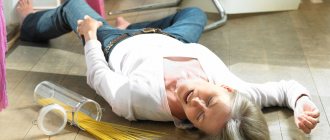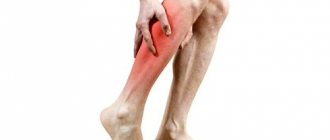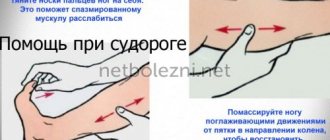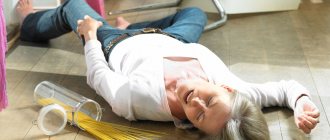Reception is conducted by:
Cramps are sudden, involuntary attacks of muscle contractions, often accompanied by loss of consciousness. The appearance of seizures is an indication to immediately call an ambulance.
The causes of seizures can be different:
- infections - meningitis, encephalitis, brain abscess;
- metabolic disorders - decreased levels of calcium, potassium, magnesium;
- high body temperature;
- epilepsy;
- brain tumors.
Let's consider providing emergency care for the most common convulsive conditions in children: epileptic seizures, convulsions due to a rise in temperature and convulsions that occur when a child cries.
Epileptic seizure
Epilepsy is a chronic disease accompanied by disorders of consciousness and seizures.
a few hours or days before the onset of seizures, you may notice motor restlessness, labile mood, increased irritability, and sleep disturbances in the child.
The attack classically begins in a child with a cry (initial cry), followed by loss of consciousness (often to coma) and convulsions. The first phase of convulsions in children lasts 10-20 s and is characterized by tension in the facial muscles and extensors of the limbs; muscles of the body, the jaws are tightly clenched, the eyeballs deviate upward and to the side. The complexion is pale at first and later becomes reddish-cyanotic. The pupils are wide. There is no breathing. The second phase lasts from 30 seconds to several minutes and is manifested by short contractions of various muscle groups of the body. In both phases of the convulsive syndrome, biting of the tongue and lips may occur.
Subsequently, the child’s convulsions gradually decrease, the muscles relax, breathing is restored, the patient is motionless, and urine and feces often pass. After 15-30 minutes, sleep sets in or the child regains consciousness, completely forgetting the seizure.
How to help a child with seizures
- Place the patient on a flat surface (the floor) and place a pillow or cushion under the head; turn your head to the side and provide access to fresh air.
- Restore airway patency: clear the oral cavity of mucus, insert a small and fairly soft object between the teeth to prevent biting the tongue, lips and damage to the teeth. It is best to tie the edge of a towel or scarf (any other fabric) into a knot and place this knot between the teeth. Using hard objects (such as a spoon) for this purpose can result in broken teeth.
- Hospitalization after emergency care in a hospital with a neurological department. In the future, selection or correction of epilepsy therapy is necessary.
Cramps in the calf muscles (cramps) causes
Crumpy can occur as a symptom of circulatory disorders in stenotic diseases of the blood vessels of the legs (can be one of the symptoms of intermittent claudication). Patients with diabetes mellitus and hypothyroidism are at risk for developing diseases of the blood vessels of the legs, since with these diseases a disorder of cholesterol metabolism will always develop and atherosclerotic plaques will form on the vessels of the legs as well. This also includes “heavy smokers.”
Cramps can occur after active physical activity on the legs, when squatting, and in the muscles of the hands, repeated spasms can occur during prolonged work with the mouse.
There are also spontaneous cramps in the muscles of the arms and legs. They may be due to hereditary characteristics and do not require special treatment.
But cramps that occur spontaneously and often in adolescence should be taken a close look at, since they may be the first sign of a hereditary enzyme defect in McArld's disease (Glycogenosis type V, myophosphorylase deficiency).
And in adults, spontaneous cramps can be the first symptom of a serious neurological disease - amyotrophic lateral sclerosis .
Convulsions in children at high temperatures
Convulsions in children occur when body temperature rises above 38 ºС during an infectious disease (acute respiratory diseases, influenza, otitis media, pneumonia, etc.).
What is typical for seizures due to fever?
Usually observed at a height of temperature and stop when it drops, they do not last long - from several seconds to several minutes; in addition, the child may lose consciousness.
How to help a child with seizures
- Lay the patient down, turn his head to the side, provide access to fresh air; restore breathing: clear the mouth and throat of mucus.
- Carry out antipyretic measures. If the child has a pronounced fever, that is, the skin is hot to the touch and has a reddish tint, then you can use:
- blowing with a fan (with caution);
- a cool, wet bandage on the forehead;
- cold on the area of large vessels (armpits, groin area);
- carry out wiping - 40% alcohol, 9% (!) table vinegar, water mixed in equal volumes (1:1:1). You can simply use alcohol with water or 9% vinegar with water in equal parts. Wipe with a cotton swab soaked in this solution (except for the face, nipples, genitals), then allow the child to dry; repeat 2-3 times.
Take paracetamol (acetaminophen, Panadol, Calpol) at a dose of 10-15 mg/kg of the child’s weight at a time or ibuprofen 5-10 mg/kg of weight (for children over 1 year old).
If a child has a background of elevated temperature: pale skin, a bluish tint to the lips and nails, cold palms and feet, chills, then wiping and other cooling measures cannot be carried out. It is necessary to warm the child and, against the background of antipyretic therapy, give no-shpa or papaverine at a dose of 1 mg/kg body weight orally (to dilate blood vessels).
An ambulance needs to be called.
Febrile seizures
Iron deficiency
9906 January 29
IMPORTANT!
The information in this section cannot be used for self-diagnosis and self-treatment.
In case of pain or other exacerbation of the disease, diagnostic tests should be prescribed only by the attending physician. To make a diagnosis and properly prescribe treatment, you should contact your doctor. Febrile seizures: causes of occurrence, what diseases cause them, diagnosis and treatment methods.
Definition
Febrile seizures are seizures in a child caused by a jump in temperature and associated with hypoxia (oxygen starvation) of the brain. Infantile febrile seizures, which are the most common seizure disorder in children, exist only in association with fever. Such seizures develop mainly in children from 6 months to 5 years, when the body temperature exceeds 38 ° C, but is not associated with an infectious lesion of the central nervous system (meningitis, encephalitis or any other disease affecting the brain).
Febrile seizures are those that occur in children with normal development, without neurological disorders, metabolic disorders or afebrile seizures in the anamnesis. With an increase in body temperature by only 1°C, the intensity of metabolic processes in the brain increases by 7-10%, therefore, the need for oxygen also increases. With a slow increase in body temperature, seizures occur much less frequently, since there is time for a proper increase in cerebral blood flow, which prevents hypoxia.
Febrile seizures are benign conditions in which high body temperature in the brain changes the electrical activity of neurons, leading to seizures.
Externally, the clinical picture looks severe: the child loses consciousness, he experiences tonic (in the form of tension) and/or clonic (in the form of twitching) motor states. Fortunately, they are usually harmless and do not indicate a serious health problem. In general, this condition has a favorable prognosis.
Hyperthermia, as a rule, contributes to the development of seizures in the presence of predisposing factors:
- perinatal pathology of the brain (complicated pregnancy and childbirth in mothers);
- hereditary factor (presence in the family of epilepsy and childhood seizures, especially similar ones).
Genetic predisposition, young age, central nervous system immaturity, and environmental factors play an important role in altering the temperature seizure threshold.
Boys are affected more often than girls (ratio 1.6 to 1). Types of febrile seizures
Clinically, febrile seizures are divided into simple and complex (or typical and atypical). Most (more than 90%) febrile seizures are simple.
Simple (benign) febrile seizures with a favorable outcome are characterized by the following symptoms:
- short duration (less than 15 minutes);
- absence of focal symptoms;
- no recurrence within a 24-hour period;
- rare (up to 2 times) relapses;
- normal psychomotor development of the child;
- absence of hereditary history of epilepsy;
- presence of cases of febrile seizures in close relatives.
A distinctive feature of complex (complicated) or atypical febrile seizures are:
- duration over 15 minutes continuously or with pauses;
- the occurrence of focal symptoms (for example, unilateral motor disorders);
- frequent recurrence during an episode of fever within 24 hours;
- delay of children in motor and psycho-speech development, cerebral palsy;
- hereditary history of epilepsy in combination with pathological changes in the electroencephalogram.
Immediately after their first appearance, and even more so after relapses, long-term preventive antiepileptic treatment is indicated.
Possible causes of febrile seizures
- Infection.
Fever causing febrile seizures is usually associated with a viral infection and, less commonly, with a bacterial infection.
The causes are thought to be the ability of individual viruses to attack the central nervous system (eg, human herpes virus type 6 [HHV-6], influenza A), which account for 30-35% of first episodes. These infections are characterized by serial, prolonged focal seizures. Bacterial infections of the upper respiratory tract, otitis media, or acute gastroenteritis caused by bacterial neurotoxins (Shigella dysenteriae) also provoke febrile seizures.
- Post-vaccination seizures.
In very rare cases, febrile seizures may occur after a child has been vaccinated against diphtheria, tetanus and whooping cough or measles-mumps-rubella. After vaccination, the child may develop a low-grade fever.
- Non-infectious factors
.
Among non-infectious factors, one can note iron and zinc deficiency, vitamin D deficiency rickets, teething, as well as causes of hyperthermia of endocrine, resorptive (the effect of drugs or toxic substances, manifested after their absorption into the blood), psychogenic, reflex genesis.
Hyponatremia may increase the risk of recurrent seizures. About 1 in 3 children who have had a febrile seizure will have another seizure during a subsequent infection. This often happens within a year of the first one.
The risk of febrile seizures in children increases if the mother smokes more than 10 cigarettes per day during pregnancy.
Which doctors to contact for febrile seizures
Febrile seizures are a condition that is not formally epilepsy, but traditionally attracts the attention of pediatricians, pediatric neurologists and epileptologists, since in some cases it can cause the development of epilepsy and the formation of persistent intellectual and neurological deficits. Consultation with a neurologist is necessary for patients with complex febrile seizures, prolonged postictal (post-seizure) impairment of consciousness, or focal neurological complications.
Diagnosis and examinations for febrile seizures
Diagnosis is based on clinical assessment; but since the examination often follows the path of excluding meningitis and encephalitis, preference is given to the relevant studies. It is also important for the pediatrician to find out the cause of the fever, for which standard tests are justified (urine and blood tests, and, if indicated, a chest x-ray).
Leg Cramps and Magnesium
Although cramps can be a simple manifestation of metabolic disorders in the muscle, for example, with chronic magnesium deficiency.
This is probably a very common reason . Magnesium is a unique mineral; it takes part in hundreds of biochemical processes in the body (according to modern ideas, about 300 biochemical processes in the human body occur with the participation of magnesium). This element is needed everywhere, and comes with food in insufficient quantities, since we eat foods rich in magnesium in small quantities (bran, nuts, pumpkin seeds, sesame). But magnesium is consumed intensively during stressful conditions (used by the nervous system), during heavy physical activity and in the heat (excreted in sweat), when drinking large amounts of liquid (excreted in the urine) and with frequent intake of alcoholic beverages. And if a muscle lacks magnesium, it becomes more prone to tension and spasms. For the same reason (magnesium deficiency), the eyelid may “twitch” - the orbicularis oculi muscle is tender and very sensitive to a lack of magnesium.
I was recently asked if there was an alternative to supplementing with magnesium other than using Magne B6. There are other preparations containing magnesium: Magnerot, Magnicum. It is believed that magnesium is well absorbed from the intestines in the presence of pyridoxine (vitamin B6) or in the form of an orotic acid salt, but in food products magnesium often comes with calcium or phosphorus, and they prevent magnesium from being absorbed in the intestines. When cooking products, its amount decreases significantly. And food products contain less and less of it due to the rapid development of “new technologies”. You can, of course, provide yourself with magnesium through proper nutrition, but you really have to want it.










